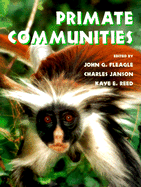Book contents
- Frontmatter
- Contents
- List of contributors
- Preface
- 1 African primate communities: Determinants of structure and threats to survival
- 2 Biomass and use of resources in south and south-east Asian primate communities
- 3 Species coexistence, distribution, and environmental determinants of neotropical primate richness: A community-level zoogeographic analysis
- 4 Primate communities: Madagascar
- 5 Primate diversity
- 6 Phylogenetic and temporal perspectives on primate ecology
- 7 Population density of primates in communities: Differences in community structure
- 8 Body mass, competition and the structure of primate communities
- 9 Convergence and divergence in primate social systems
- 10 Of mice and monkeys: Primates as predictors of mammal community richness
- 11 Comparing communities
- 12 Large-scale patterns of species richness and species range size in anthropoid primates
- 13 The recent evolutionary past of primate communities: Likely environmental impacts during the past three millennia
- 14 Resources and primate community structure
- 15 Effects of subsistence hunting and forest types on the structure of Amazonian primate communities
- 16 Spatial and temporal scales in primate community structure
- 17 Primate communities in Africa: The consequences of long-term evolution or the artifact of recent hunting?
- 18 The future of primate communities: A reflection of the present?
- 19 Concluding remarks
- Systematic index
- Subject index
14 - Resources and primate community structure
Published online by Cambridge University Press: 21 August 2009
- Frontmatter
- Contents
- List of contributors
- Preface
- 1 African primate communities: Determinants of structure and threats to survival
- 2 Biomass and use of resources in south and south-east Asian primate communities
- 3 Species coexistence, distribution, and environmental determinants of neotropical primate richness: A community-level zoogeographic analysis
- 4 Primate communities: Madagascar
- 5 Primate diversity
- 6 Phylogenetic and temporal perspectives on primate ecology
- 7 Population density of primates in communities: Differences in community structure
- 8 Body mass, competition and the structure of primate communities
- 9 Convergence and divergence in primate social systems
- 10 Of mice and monkeys: Primates as predictors of mammal community richness
- 11 Comparing communities
- 12 Large-scale patterns of species richness and species range size in anthropoid primates
- 13 The recent evolutionary past of primate communities: Likely environmental impacts during the past three millennia
- 14 Resources and primate community structure
- 15 Effects of subsistence hunting and forest types on the structure of Amazonian primate communities
- 16 Spatial and temporal scales in primate community structure
- 17 Primate communities in Africa: The consequences of long-term evolution or the artifact of recent hunting?
- 18 The future of primate communities: A reflection of the present?
- 19 Concluding remarks
- Systematic index
- Subject index
Summary
INTRODUCTION
The concept of carrying capacity is fundamental in determining a species' density and biomass, which enter into the equations used in ecological theory to predict species diversity and community structure (MacArthur, 1972). Therefore, you might think that a great deal was known about how to determine the carrying capacity of species in nature; however, this is not the case. In the vast majority of species, if the carrying capacity is measured at all, it is estimated as the population density of individuals associated with a zero growth rate (Dennis & Taper, 1994). The more fundamental question of what resources determine that population level is often left unanswered.
Debate has raged over the past two decades as to the extent or even existence of resource limitation in primate populations. Early observations (Struhsaker, 1969) suggested that many fruit-eating primates faced an overabundance of resources in the trees that they used. Later study quantitatively confirmed that some trees produced more fruit than a group of monkeys could consume in one sitting (Janson, 1988b), but also showed that many trees did not produce enough fruit to satiate even a single animal. In one of the few attempts to relate primate population densities to resources directly, Coehlo et al. (1976) compared the biomass and consumption rates of howler and spider monkeys in Guatemala to the availability of the major food resources that they used. They found that over an annual cycle total food production vastly exceeded the requirements of the population density in that site. However, in Peru, Janson (1984) found that the productivity per unit area of food species used by capuchin monkeys varied enough so that in the dry season insufficient fruit was produced to sustain the population. At that time, these fruit-eating monkeys were seen to switch to alternate plant products.
- Type
- Chapter
- Information
- Primate Communities , pp. 237 - 267Publisher: Cambridge University PressPrint publication year: 1999
- 122
- Cited by



